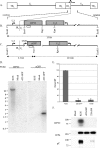Transient expression of herpes simplex virus type 1 ICP22 represses viral promoter activity and complements the replication of an ICP22 null virus
- PMID: 19535441
- PMCID: PMC2738139
- DOI: 10.1128/JVI.00810-09
Transient expression of herpes simplex virus type 1 ICP22 represses viral promoter activity and complements the replication of an ICP22 null virus
Abstract
Of the five herpes simplex virus type 1 immediate early (IE) proteins, the least is known about the function of ICP22 during productive infection and latency. Research characterizing the physical and functional properties of the protein has been limited because ICP22 has proven to be difficult to express in transient assays. In addition, genetic analysis of ICP22 has been complicated by the fact that the C terminus of ICP22 is expressed as a discrete protein product. In order to characterize properties of mutant and wild-type ICP22, we developed a transient expression system. We found that ICP22 can be expressed at detectable levels when placed under the control of the cytomegalovirus IE promoter, confirming recent observations by K. A. Fraser and S. A. Rice (J. Virol. 81:5091-5101, 2007). We extended this analysis to show that ICP22 can also be expressed from its own promoter in the presence of other viral factors, either by coexpression with ICP0 or by infection with an ICP22 null virus. Notably, infection of cells transfected with an ICP22 expression vector yielded ICP22 protein that was modified in a manner similar to that of ICP22 protein detected in wild-type-infected cells. We go on to demonstrate that the failure of ICP22 protein to be expressed in transiently transfected cells was not due to inactivity of the ICP22 promoter, but rather to the ability of ICP22 to inhibit expression of reporter gene activity, including its own, in transient assays. Of special note was the observation that expression of ICP22 was sufficient to prevent transactivation of reporter genes by ICP0. Finally, transient expression of ICP22 was sufficient to complement replication of an ICP22 null virus, demonstrating that this system can be used to study functional properties of ICP22. Collectively, this transient expression system facilitates tests of the physical and functional properties of ICP22 and ICP22 mutants prior to introduction of mutant genes into the viral genome.
Figures






Similar articles
-
Suppression of CD80 Expression by ICP22 Affects Herpes Simplex Virus Type 1 Replication and CD8+IFN-γ+ Infiltrates in the Eyes of Infected Mice but Not Latency Reactivation.J Virol. 2021 Sep 9;95(19):e0103621. doi: 10.1128/JVI.01036-21. Epub 2021 Sep 9. J Virol. 2021. PMID: 34287036 Free PMC article.
-
Characterization of regulatory functions of the HSV-1 immediate-early protein ICP22.Virology. 1996 Dec 15;226(2):393-402. doi: 10.1006/viro.1996.0667. Virology. 1996. PMID: 8955059
-
Evidence that the herpes simplex virus type 1 ICP0 protein does not initiate reactivation from latency in vivo.J Virol. 2006 Nov;80(22):10919-30. doi: 10.1128/JVI.01253-06. Epub 2006 Aug 30. J Virol. 2006. PMID: 16943285 Free PMC article.
-
The herpes simplex virus type 1 infected cell protein 22.Virol Sin. 2010 Feb;25(1):1-7. doi: 10.1007/s12250-010-3080-x. Epub 2010 Feb 12. Virol Sin. 2010. PMID: 20960278 Free PMC article. Review.
-
HSV-1 ICP22: hijacking host nuclear functions to enhance viral infection.Future Microbiol. 2013 Mar;8(3):311-21. doi: 10.2217/fmb.13.4. Future Microbiol. 2013. PMID: 23464370 Review.
Cited by
-
Suppression of CD80 Expression by ICP22 Affects Herpes Simplex Virus Type 1 Replication and CD8+IFN-γ+ Infiltrates in the Eyes of Infected Mice but Not Latency Reactivation.J Virol. 2021 Sep 9;95(19):e0103621. doi: 10.1128/JVI.01036-21. Epub 2021 Sep 9. J Virol. 2021. PMID: 34287036 Free PMC article.
-
Proteomic characterization of pseudorabies virus extracellular virions.J Virol. 2011 Jul;85(13):6427-41. doi: 10.1128/JVI.02253-10. Epub 2011 Apr 27. J Virol. 2011. PMID: 21525350 Free PMC article.
-
Herpes Simplex Virus 1 ICP22 Suppresses CD80 Expression by Murine Dendritic Cells.J Virol. 2019 Jan 17;93(3):e01803-18. doi: 10.1128/JVI.01803-18. Print 2019 Feb 1. J Virol. 2019. PMID: 30404803 Free PMC article.
-
Host factors associated with either VP16 or VP16-induced complex differentially affect HSV-1 lytic infection.Rev Med Virol. 2022 Nov;32(6):e2394. doi: 10.1002/rmv.2394. Epub 2022 Sep 7. Rev Med Virol. 2022. PMID: 36069169 Free PMC article. Review.
-
Herpes simplex virus 1 ICP22 inhibits the transcription of viral gene promoters by binding to and blocking the recruitment of P-TEFb.PLoS One. 2012;7(9):e45749. doi: 10.1371/journal.pone.0045749. Epub 2012 Sep 24. PLoS One. 2012. PMID: 23029222 Free PMC article.
References
-
- Balliet, J. W., J. C. Min, M. S. Cabatingan, and P. A. Schaffer. 2005. Site-directed mutagenesis of large DNA palindromes: construction and in vitro characterization of herpes simplex virus type 1 mutants containing point mutations that eliminate the oriL or oriS initiation function. J. Virol. 7912783-12797. - PMC - PubMed
-
- Cun, W., M. Hong, L. D. Liu, C. H. Dong, J. Luo, and Q. H. Li. 2006. Structural and functional characterization of herpes simplex virus 1 immediate-early protein infected-cell protein 22. J. Biochem. 14067-73. - PubMed
-
- Davido, D. J., and D. A. Leib. 1998. Analysis of the basal and inducible activities of the ICPO promoter of herpes simplex virus type 1. J. Gen. Virol. 792093-2098. - PubMed
-
- Kwun, H. J., S. W. Yim, D. H. Lee, and K. L. Jang. 1999. Activation of the thymidine kinase promoter by herpes simplex virus type 1 immediate early proteins. Mol. Cells 9277-280. - PubMed
Publication types
MeSH terms
Substances
Grants and funding
LinkOut - more resources
Full Text Sources

